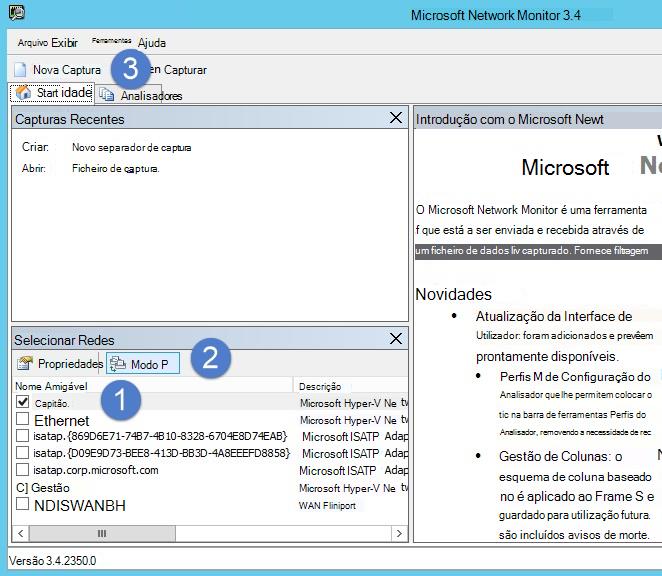Validar Espelhamento de Porta
Aplica-se a: Advanced Threat Analytics versão 1.9
Observação
Este artigo só é relevante se implementar ATA Gateways em vez de ATA Lightweight Gateways. Para determinar se precisa de utilizar os ATA Gateways, veja Escolher os gateways certos para a sua implementação.
Os passos seguintes orientam-no ao longo do processo para validar que o espelhamento de porta está configurado corretamente. Para que o ATA funcione corretamente, o ATA Gateway tem de conseguir ver o tráfego de e para o controlador de domínio. A main origem de dados utilizada pelo ATA é uma inspeção aprofundada de pacotes do tráfego de rede de e para os controladores de domínio. Para o ATA ver o tráfego de rede, o espelhamento de porta tem de ser configurado. O espelhamento de porta copia o tráfego de uma porta (a porta de origem) para outra porta (a porta de destino).
Validar o espelhamento de porta com um script de Windows PowerShell
- Guarde o texto deste script num ficheiro chamado ATAdiag.ps1.
- Execute este script no ATA Gateway que pretende validar. O script gera tráfego ICMP do ATA Gateway para o controlador de domínio e procura esse tráfego na NIC de Captura no controlador de domínio. Se o ATA Gateway vir o tráfego ICMP com um endereço IP de destino da mesma forma que o IP dc endereçado que introduziu na ATA Console, considera que o espelhamento de porta está configurado.
Exemplo de como executar o script:
# ATAdiag.ps1 -CaptureIP n.n.n.n -DCIP n.n.n.n -TestCount n
param([parameter(Mandatory=$true)][string]$CaptureIP, [parameter(Mandatory=$true)][string]$DCIP, [int]$PingCount = 10)
# Set variables
$ErrorActionPreference = "stop"
$starttime = get-date
$byteIn = new-object byte[] 4
$byteOut = new-object byte[] 4
$byteData = new-object byte[] 4096 # size of data
$byteIn[0] = 1 # for promiscuous mode
$byteIn[1-3] = 0
$byteOut[0-3] = 0
# Convert network data to host format
function NetworkToHostUInt16 ($value)
{
[Array]::Reverse($value)
[BitConverter]::ToUInt16($value,0)
}
function NetworkToHostUInt32 ($value)
{
[Array]::Reverse($value)
[BitConverter]::ToUInt32($value,0)
}
function ByteToString ($value)
{
$AsciiEncoding = new-object system.text.asciiencoding
$AsciiEncoding.GetString($value)
}
Write-Host "Testing Port Mirroring..." -ForegroundColor Yellow
Write-Host ""
Write-Host "Here is a summary of the connection we will test." -ForegroundColor Yellow
# Initialize a first ping connection
Test-Connection -Count 1 -ComputerName $DCIP -ea SilentlyContinue
Write-Host ""
Write-Host "Press any key to continue..." -ForegroundColor Red
[void][System.Console]::ReadKey($true)
Write-Host ""
Write-Host "Sending ICMP and Capturing data..." -ForegroundColor Yellow
# Open a socket
$socket = new-object system.net.sockets.socket([Net.Sockets.AddressFamily]::InterNetwork,[Net.Sockets.SocketType]::Raw,[Net.Sockets.ProtocolType]::IP)
# Include the IP header
$socket.setsocketoption("IP","HeaderIncluded",$true)
$socket.ReceiveBufferSize = 10000
$ipendpoint = new-object system.net.ipendpoint([net.ipaddress]"$CaptureIP",0)
$socket.bind($ipendpoint)
# Enable promiscuous mode
[void]$socket.iocontrol([net.sockets.iocontrolcode]::ReceiveAll,$byteIn,$byteOut)
# Initialize test variables
$tests = 0
$TestResult = "Noise"
$OneSuccess = 0
while ($tests -le $PingCount)
{
if (!$socket.Available) # see if any packets are in the queue
{
start-sleep -milliseconds 500
continue
}
# Capture traffic
$rcv = $socket.receive($byteData,0,$byteData.length,[net.sockets.socketflags]::None)
# Decode the header so we can read ICMP
$MemoryStream = new-object System.IO.MemoryStream($byteData,0,$rcv)
$BinaryReader = new-object System.IO.BinaryReader($MemoryStream)
# Set IP version & header length
$VersionAndHeaderLength = $BinaryReader.ReadByte()
# TOS
$TypeOfService= $BinaryReader.ReadByte()
# More values, and the Protocol Number for ICMP traffic
# Convert network format of big-endian to host format of little-endian
$TotalLength = NetworkToHostUInt16 $BinaryReader.ReadBytes(2)
$Identification = NetworkToHostUInt16 $BinaryReader.ReadBytes(2)
$FlagsAndOffset = NetworkToHostUInt16 $BinaryReader.ReadBytes(2)
$TTL = $BinaryReader.ReadByte()
$ProtocolNumber = $BinaryReader.ReadByte()
$Checksum = [Net.IPAddress]::NetworkToHostOrder($BinaryReader.ReadInt16())
# The source and destination IP addresses
$SourceIPAddress = $BinaryReader.ReadUInt32()
$DestinationIPAddress = $BinaryReader.ReadUInt32()
# The source and destimation ports
$sourcePort = [uint16]0
$destPort = [uint16]0
# Close the stream reader
$BinaryReader.Close()
$memorystream.Close()
# Cast DCIP into an IPaddress type
$DCIPP = [ipaddress] $DCIP
$DestinationIPAddressP = [ipaddress] $DestinationIPAddress
#Ping the DC at the end after starting the capture
Test-Connection -Count 1 -ComputerName $DCIP -ea SilentlyContinue | Out-Null
# This is the match logic - check to see if Destination IP from the Ping sent matches the DCIP entered by in the ATA Console
# The only way the ATA Gateway should see a destination of the DC is if Port Spanning is configured
if ($DestinationIPAddressP -eq $DCIPP) # is the destination IP eq to the DC IP?
{
$TestResult = "Port Spanning success!"
$OneSuccess = 1
} else {
$TestResult = "Noise"
}
# Put source, destination, test result in Powershell object
new-object psobject | add-member -pass noteproperty CaptureSource $([system.net.ipaddress]$SourceIPAddress) | add-member -pass noteproperty CaptureDestination $([system.net.ipaddress]$DestinationIPAddress) | Add-Member -pass NoteProperty Result $TestResult | Format-List | Out-Host
#Count tests
$tests ++
}
if ($OneSuccess -eq 1)
{
Write-Host "Port Spanning Success!" -ForegroundColor Green
Write-Host ""
Write-Host "At least one packet which was addressed to the DC, was picked up by the Gateway." -ForegroundColor Yellow
Write-Host "A little noise is OK, but if you don't see a majority of successes, you might want to re-run." -ForegroundColor Yellow
} else {
Write-Host "No joy, all noise. You may want to re-run, increase the number of Ping Counts, or check your config." -ForegroundColor Red
}
Write-Host ""
Write-Host "Press any key to continue..." -ForegroundColor Red
[void][System.Console]::ReadKey($true)
Validar o espelhamento de porta com o Net Mon
Instale o Microsoft Network Monitor 3.4 no ATA Gateway que pretende validar.
Importante
Não instale o Microsoft Message Analyzer ou qualquer outro software de captura de tráfego no ATA Gateway.
Abra o Monitor de Rede e crie um novo separador de captura.
Selecione apenas o adaptador de rede Capture ou o adaptador de rede que está ligado à porta de comutador que está configurada como o destino do espelhamento de porta.
Certifique-se de que o Modo P está ativado.
Clique em Nova Captura.

Na janela Filtro de Visualização, introduza o seguinte filtro: KerberosV5 OU LDAP e, em seguida, clique em Aplicar.

Clique em Iniciar para iniciar a sessão de captura. Se não vir tráfego de e para o controlador de domínio, reveja a configuração do espelhamento de porta.

Observação
É importante certificar-se de que vê tráfego de e para os controladores de domínio.
Se apenas vir o tráfego numa direção, deve trabalhar com as suas equipas de rede ou virtualização para ajudar a resolver problemas com a configuração do espelhamento de porta.